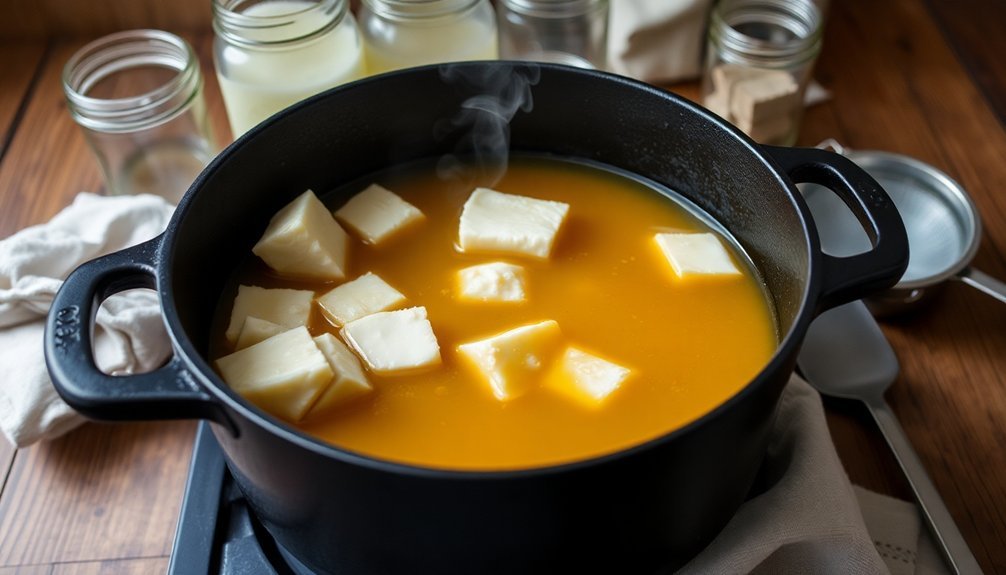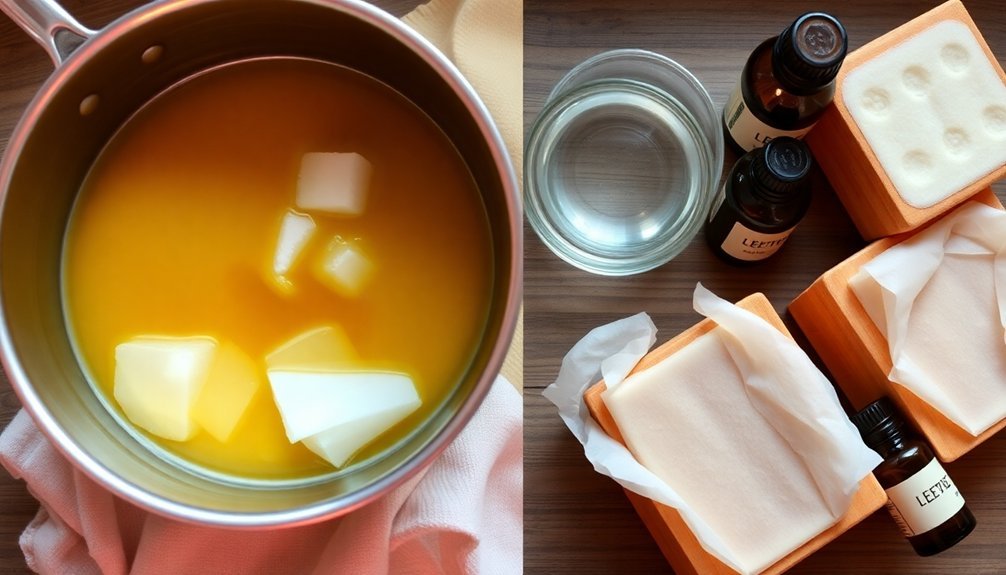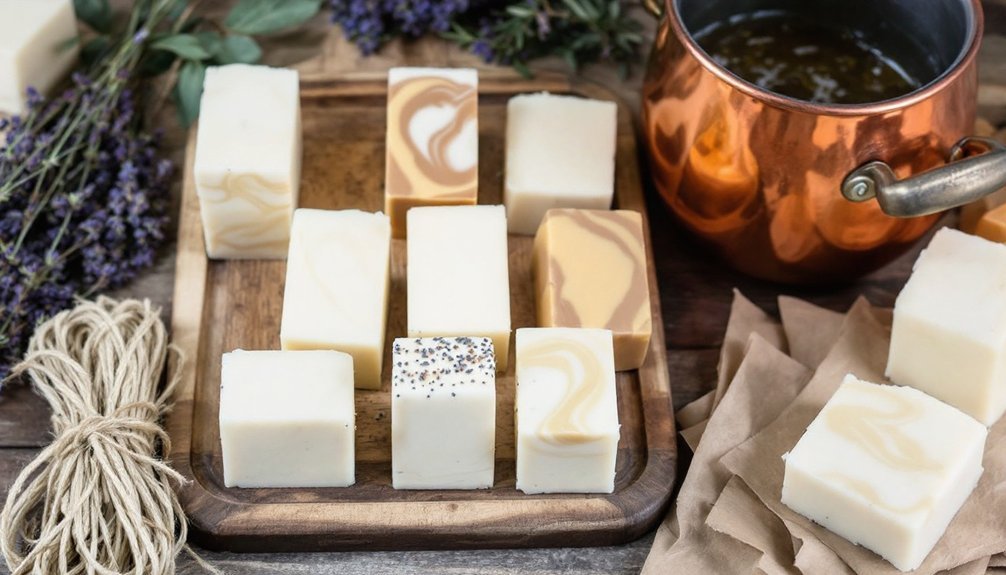To make deer tallow soap at home, you'll need to render fresh deer fat in a slow cooker for 10-12 hours, removing impurities as it melts. Once you've got pure tallow, combine it with olive oil and coconut oil at 110°F, then carefully mix in your calculated lye solution. Blend until the mixture reaches "trace" consistency, pour into lined molds, and let it set for 24 hours. After cutting into bars, cure for 4-6 weeks. The key details of this traditional craft reveal themselves in the process.
Essential Equipment and Safety Gear

Making deer tallow soap requires careful preparation with the right tools and safety equipment.
You'll need essential equipment including a digital scale for precise measurements, a slow cooker to render the fat, and soap molds to shape your final product.
Don't forget to set up in a well-ventilated area to avoid breathing harmful fumes during the lye mixing process.
Your safety gear must include protective gloves, goggles, and long-sleeved clothing to prevent lye burns.
Always prioritize safety by wearing protective gloves, goggles, and long sleeves when working with lye to prevent dangerous chemical burns.
Keep a bottle of vinegar nearby to neutralize any accidental spills.
For straining the rendered deer fat, you'll want cheesecloth or a mesh strainer to remove impurities before soap making begins.
Having all these items ready before you start guarantees a safe and successful soap-making experience.
Rendering Deer Fat Into Pure Tallow

Start by trimming fat from your freshly skinned deer and cutting it into small pieces or grinding it for ideal melting efficiency.
You'll need to place the prepared fat in your slow cooker, set it to low heat, and maintain the rendering process for 10-12 hours while stirring every two hours.
For best results, remove floating solids with a slotted spoon throughout the process, and once completely melted, let the tallow cool and solidify before scraping off any remaining impurities.
Preparing Raw Fat Pieces
The successful rendering of deer tallow begins with proper fat preparation immediately after skinning your deer.
You'll need to thoroughly trim all fat from the carcass, making sure to remove any attached meat or connective tissue that could affect the final product's quality.
Once you've collected the fat, chop or grind it into small, uniform pieces.
This step is vital as smaller pieces will render the fat more efficiently in your slow cooker. The finer consistency allows for even heating and faster melting, which is essential for producing high-quality tallow suitable for soap making.
Before you begin the rendering process, remove any visible impurities from the raw fat pieces.
When properly prepared, these fat pieces will melt down into pure tallow with a high melt point, which you can later solidify and store in jars.
Safe Slow Cooker Method
Once you've prepared your deer fat pieces, rendering them into pure tallow requires patience and careful temperature control.
Start by placing your trimmed fat into a slow cooker and setting it to low heat. You'll need to monitor the rendering process for 10-12 hours, stirring every 2 hours to guarantee the fat melts evenly.
As the melting progresses, you'll notice impurities rising to the surface. Remove these with a slotted spoon to maintain the tallow's purity.
After the rendering is complete, let your deer tallow cool and solidify naturally. Once solid, scrape off any remaining surface impurities for the cleanest possible product.
For soap making or other uses, store your rendered tallow in sealed jars to preserve its freshness. This careful process guarantees you'll have high-quality tallow ready for your projects.
Understanding Lye Calculations

Proper lye calculations form the cornerstone of successful soap making with deer tallow.
You'll need to understand the specific fatty acid profile of your deer tallow to determine the correct lye-to-fat ratio. Using an online soap calculator, you can guarantee precise measurements for a moisturizing bar that's safe and effective.
For accurate lye calculations, follow these essential steps:
- Calculate your total fat weight and multiply by 0.33 to determine approximate lye needs.
- Input your deer tallow weight into a soap calculator to get the exact saponification value.
- Factor in your desired superfat percentage (typically 5%) to prevent excess lye.
- Double-check all measurements before mixing, as precision is vital for proper saponification.
Preparing Your Soap Making Workspace

Establishing a safe, organized workspace marks your first critical step in deer tallow soap making.
You'll need a well-ventilated area free from clutter, with a heat-resistant surface for melting your deer tallow. Set up your station with all essential supplies within arm's reach: lye, distilled water, protective gear, and your immersion blender.
Before starting the soap-making process, put on your safety equipment, including goggles and gloves, as lye can be dangerous.
Place your digital scale, mixing containers, thermometer, and slotted spoon in logical positions to maintain efficiency. Line your molds with parchment paper to guarantee easy removal later.
Remember to keep your workspace organized and clean throughout the process, as this will help you maintain focus on precise measurements and proper mixing techniques.
Combining Oils and Creating the Base

You'll need to carefully weigh 13 oz of deer tallow, 19.5 oz of olive oil, and 13 oz of coconut oil using a digital scale to guarantee precise measurements for your soap base.
Heat the deer tallow and coconut oil together until melted, then combine with olive oil, maintaining all components at 110°F before mixing with your lye solution.
Continue blending the mixture until it reaches "trace," indicated by the batter leaving a visible trail on its surface when drizzled.
Precise Measurement Guidelines
Three essential measurements form the foundation of your deer tallow soap: 13 oz of deer tallow, 19.5 oz of olive oil, and 13 oz of coconut oil.
You'll need a digital scale to guarantee precise measurements for your balanced soap base. For the lye solution, combine 6.45 oz of soap-grade lye with 8.5 oz of distilled water.
To achieve perfect saponification, follow these critical steps:
- Weigh all oils individually using a digital scale
- Use a soap calculator to verify your lye-to-oil ratio
- Add lye to water (never reverse this order)
- Cool both your lye solution and oil mixture below 110°F before combining
Proper Temperature Control
When working with deer tallow soap, maintaining precise temperature control becomes critical for successful saponification.
Start by heating your deer tallow, coconut oil, and castor oil mixture to 125°F (52°C) to guarantee proper emulsification. You'll need to let both the lye solution and melted oils cool to below 110°F before combining them.
Use a digital thermometer to monitor temperatures throughout the process – this isn't a step you can eyeball.
Once your ingredients reach the right temperature, blend the lye solution into the melted oils using a stick blender until you achieve trace consistency.
Remember that temperature control directly affects your soap's outcome. If it's too hot, your mixture might seize; too cold, and you'll struggle to reach proper trace.
Keep checking temperatures regularly for the best results.
Mixing Until Trace
Once your oils and lye solution have reached the proper temperature, combining them marks a significant phase in the soap-making process.
Before mixing your deer tallow blend with the lye mixture, confirm both components have completed the cooling process to below 110°F. This temperature control is essential for proper saponification.
Use your immersion blender to combine the ingredients until you achieve trace, which typically takes 5-10 minutes.
Here's what to monitor:
- Watch for a pudding-like consistency to develop
- Look for visible lines when mixture is dripped from a spoon
- If the mixture seizes, apply gentle heat to soften it
- Add your additives and essential oils once trace occurs
The mixture will thicken gradually, indicating that saponification is in progress.
Keep blending until you achieve the desired consistency before moving to the molding phase.
Achieving Perfect Trace Consistency
To achieve the perfect trace consistency in your deer tallow soap, you'll need to carefully monitor the mixture as it transforms from a thin liquid into a pudding-like texture. Start by ensuring your lye solution and melted deer tallow are below 110°F before combining them. Use a stick blender to speed up saponification, blending intermittently for 5-10 minutes.
| Stage | Consistency | Test Method |
|---|---|---|
| Early | Thin liquid | Drips quickly |
| Medium | Custard-like | Leaves brief trail |
| Full | Pudding-like | Trail remains visible |
If your mixture begins to seize, don't panic. Simply cover the pot and warm it gently until it softens. Perform a drip test by letting the mixture fall onto the surface – when it leaves a visible trail for several seconds, you've reached the perfect trace consistency.
Molding and Initial Setting Process
After achieving the perfect trace consistency, you'll need to carefully prepare your molds for the soap setting process.
Achieving proper trace consistency is crucial before moving on to preparing your molds for the soap setting phase.
Start by lining your molds with parchment paper, which guarantees easy removal of your hardened soap later.
Follow these essential steps for successful molding:
- Pour your liquid soap mixture into the lined molds, making sure to distribute it evenly for uniform bars.
- Let the soap set undisturbed for a full 24 hours to achieve proper hardening.
- Once hardened, gently remove the soap from the molds by lifting the parchment paper.
- Use a sharp knife to cut your soap into uniform bars of your desired size.
These careful molding techniques will help you create professional-looking soap bars that are easy to handle and store.
The Art of Curing Deer Tallow Soap
Now that your soap bars are cut and ready, the real transformation begins during the curing phase.
You'll need to cure your deer tallow soap for at least 4 weeks to achieve ideal results. During this time, excess moisture evaporates, allowing your soap to harden properly.
Place your soap bars on a wire rack to guarantee proper airflow on all sides. Keep them in a cool, dry area away from direct sunlight to maintain their quality.
While you might be tempted to use your soap after two weeks, resist the urge. The full curing period greatly improves both lather quality and longevity.
Check your bars periodically throughout the curing process to monitor their progress. Remember, patience is key – the longer you let your soap cure, the better it'll perform and the longer each bar will last.
Testing and Quality Assessment
When testing your deer tallow soap's quality, safety checks should be your top priority.
After cooking your soap for 60 minutes to guarantee complete saponification, you'll need to perform several quality assessments before using it.
Properly testing handmade soap after saponification ensures safety and quality before any skin contact or regular use.
Follow these essential testing steps:
- Taste a tiny drop of the soap mixture – if it stings, there's residual lye present, indicating more cooking time is needed.
- Check the trace consistency – a thin trace shows proper mixing, while thick trace requires temperature or measurement adjustments.
- Allow for a proper curing period of 2-6 weeks to enhance the soap's properties.
- Evaluate user feedback on hardness, lather quality, and moisturizing effects.
You can begin initial testing after two weeks, though the deer tallow soap's qualities will continue improving throughout the curing process.
Frequently Asked Questions
How to Make Deer Fat Tallow?
You'll need to trim deer fat after skinning, grind it into pieces, and slow cook on low for 10-12 hours. Stir occasionally, remove solids, let cool, scrape impurities, and store in containers.
Is Deer Tallow Good for Soap-Making?
Yes, you'll find deer tallow excellent for soap-making. It's hypoallergenic, creates long-lasting bars, and produces rich, silky lather. You'll also benefit from its omega-3 acids and natural moisturizing properties when making soap.
What Are the Disadvantages of Tallow Soap?
You'll find tallow soap can have an unpleasant animal scent, feels less moisturizing, and produces fewer suds. It might conflict with your ethical values if you're vegan, and poor-quality tallow can affect the soap's longevity.
Is Deer Tallow Good for Skin?
Yes, deer tallow's great for your skin! You'll benefit from its omega-3 fatty acids, vitamins A, D, E, and K, and hypoallergenic properties. It'll keep your skin moisturized, nourished, and healthy while providing gentle cleansing.
In Summary
You've now mastered the art of making deer tallow soap at home. With proper safety precautions, careful measurements, and patience during the curing process, you'll have created a natural, sustainable soap that honors the whole-animal tradition. Don't forget to test the final pH and hardness before using. Once you're confident in the results, you'll enjoy a unique, handcrafted soap that connects you to traditional craftsmanship.





Leave a Reply